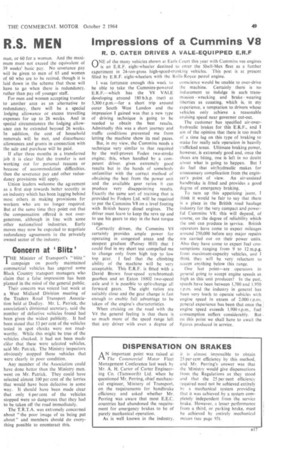Impressions of a Cummins V8
Page 51

If you've noticed an error in this article please click here to report it so we can fix it.
R. D. CATER DRIVES A VALE-EQUIPPED. E.R.F ONE of the many vehicles shown at Earls Court this year with Cummins vee engines is an E.R.F. eight-wheeler destined to enter the Shell-Mex fleet as a further experiment in 24-ton-gross high-speed-trunking vehicles. This post is at present filled by E.R.F. eight-wheelers with the Rolls-Royce petrol engine.
I was fortunate enough this week to be able to take the Cummins-powered E.R.F.—which has the V8 VALE developing around 180 b.h.p. (net) at 3,300 r.p.m.—for a short trip around outer South West London and the impression I gained was that a new type of driving technique is going to be needed to obtain the best results. Admittedly this was a short journey and traffic conditions prevented me from letting the machine show its real paces.
But, in my view, the Cummins needs a technique very similar to that required by the well-proven Foden two-stroke engine; this, when handled by a competent driver, gives extremely good results but in the hands of somebody unfamiliar with the correct method of obtaining the best from the power unit and the available gear ratios it can prod uce very disappointing resuIts Exactly the same sort of training that is provided by Forlens Ltd. will be required to put the Cummins V8 on a level footing with British heavy diesel engines. The driver must learn to keep the revs up and to use his gears to stay in the best torque range.
Correctly driven, the Cummins V. certainly provides ample power for operating in congested areas and the steepest gradient (Putney Hill) that I could find in my short test compelled me to change only from high top to low top gear. I feel that the climbing ability of the machine will be very acceptable. This E.R.F. is fitted with a David Brown four-speed synchromesh gearbox and an Eaton 18802 two-speed axle and it is possible to split-change all forward gears. The eight ratios are suitably close and the gear change is fast enough to enable full advantage to be taken of the engine's characteristics.
When cruising on the road with the V8 the general feeling is that there is so much more of the speed range left that any driver with even a degree of conscience would be unable to over-drive the machine. Certainly there is no inducement to indulge in such transmission wrecking and brake wearing liberties as coasting, which is, in my experience, a temptation to drivers whose vehicles only achieve a reasonable cruising speed near governor cut-out.
The customer has specified air-overhydraulic brakes for this E.R.F., and I am of the opinion that there is too much of a time lag on this type of braking to make for really safe operation in heavily trafficked areas. Ultimate braking power, however, is extremely good and, once the shoes are biting, one is left in no doubt about what is going to happen. But I do feel that air/hydraulic makes for unnecessary complication from the engineer's point of view. An air-assisted handbrake is fitted and provides a good degree of emergency braking.
To sum up this appetizing jaunt, I think it would be fair to say that there is a place in the British road haulage industry for the very compact and powerful Cummins V8; this will depend, of course, on the degree of reliability which the unit can produce in service. British operators have come to expect mileages around 250,000 before any major repairs are carried out on their power units. Also they have come to expect fuel consumptions ranging from 9 to 12 m.p.g. from maximum-capacity vehicles, and I think they will be very reluctant to accept anything below this range.
One last point—are operators in general going to accept engine speeds as high as this unit produces? In the past, speeds have been between 1,700 and L950 and the industry in general has been very loath to operate vehicles with engine speed in excess of 2.000 r.p.ro; general experience has been that once the engine speed exceeds 1,900 r.p.m„ fuel consumption suffers considerably. But . on this point we shall have to await the figures produced in service.






























































































































































































































